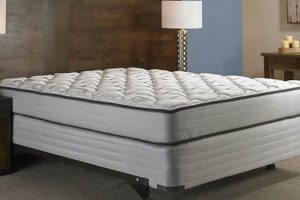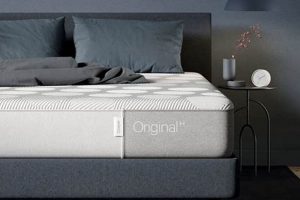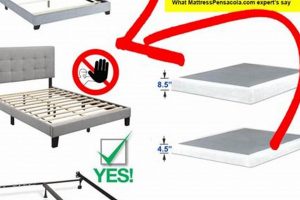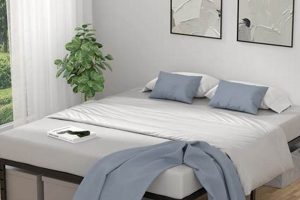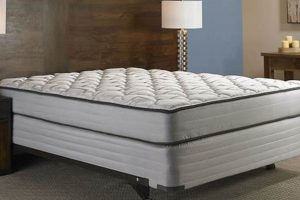A bed setup that incorporates a low-profile frame, traditionally a platform bed, in conjunction with both a box spring and a mattress represents a specific approach to bed construction. This combination aims to provide a particular level of support and height. The platform frame serves as the foundation, while the box spring offers additional shock absorption and elevation for the mattress. This setup deviates from the standard platform bed design, which often eliminates the need for a box spring due to its inherent support system.
Employing both a box spring and a mattress on a platform frame can offer enhanced comfort and longevity for the sleeping surface. The additional height can be beneficial for individuals with mobility limitations. Historically, the box spring was integral to bed design, providing crucial support for innerspring mattresses. This layered configuration allows for a customizable sleeping experience tailored to individual preferences for firmness and height. While the design might seem redundant with modern platform beds, certain users continue to value the traditional feel and support it provides.
The following discussion explores the advantages and disadvantages of this particular bed construction method, examining its potential impact on mattress lifespan, overall cost, and aesthetic appeal within various bedroom designs. Furthermore, alternative bed setups will be considered, allowing for a comprehensive comparison to assist in informed purchasing decisions.
Considerations for Platform Bed Use with Box Spring and Mattress
The following guidelines address key considerations when utilizing a platform bed in conjunction with a box spring and mattress. These tips aim to optimize the functionality and longevity of the chosen sleeping arrangement.
Tip 1: Assess Frame Compatibility: Verify that the platform bed frame is structurally sound enough to support the combined weight of the mattress, box spring, and occupants. Inadequate support can lead to frame damage and compromise the sleeping experience.
Tip 2: Measure Clearance: Precisely measure the overall height achieved with the platform frame, box spring, and mattress combination. Ensure that the resulting bed height is appropriate for user accessibility and bedroom aesthetics. Excess height can hinder entry and exit.
Tip 3: Evaluate Mattress Type: Consider the type of mattress being used. Certain mattress types, such as memory foam, may not benefit significantly from the added support of a box spring when placed on a solid platform base. Research mattress specifications for optimal support requirements.
Tip 4: Prioritize Ventilation: When using a box spring on a platform bed, ensure adequate ventilation beneath the mattress. Insufficient airflow can trap moisture, potentially leading to mold or mildew growth. Consider a platform frame with slats to enhance air circulation.
Tip 5: Inspect Support Structure: Regularly inspect the platform bed’s support structure, including slats or solid surfaces, for signs of wear or damage. Promptly repair or replace damaged components to maintain adequate support and prevent premature mattress wear.
Tip 6: Account for Room Aesthetics: Acknowledge the visual impact of the increased bed height. The combination of a platform bed, box spring, and mattress may alter the overall proportions of the room. Consider the room’s dimensions and dcor when making a decision.
Tip 7: Evaluate Long-Term Cost: Factor in the additional cost of the box spring when evaluating this setup. While it may offer immediate comfort benefits, consider the long-term cost compared to alternative mattress support systems that may not require a box spring.
Implementing these considerations helps maximize the benefits and mitigate potential drawbacks of utilizing a platform bed with a box spring and mattress, ultimately promoting a more comfortable and sustainable sleep environment.
The subsequent sections will explore alternative bed frame options and delve into specific mattress types to further inform the decision-making process for optimal sleep system selection.
1. Combined Height Considerations
Combined height is a crucial factor when selecting a platform bed, box spring, and mattress combination. The overall height of the assembled bed impacts accessibility, aesthetics, and even perceived comfort. Careful evaluation is necessary to ensure the final configuration meets individual needs and preferences.
- Accessibility and Ergonomics
The total height directly affects ease of entry and exit from the bed. Excessive height can pose challenges for individuals with mobility limitations, while insufficient height might require excessive bending. Ergonomically, a height allowing the user to sit comfortably with feet flat on the floor is generally desirable.
- Aesthetic Proportions within the Room
The bed’s height influences the visual balance of the room. A very tall bed may overwhelm a small space, while a low bed could appear insignificant in a larger room. Consideration of ceiling height, furniture scale, and overall design style is essential for achieving visual harmony. A platform beds inherently low profile is altered significantly when a box spring is added.
- Mattress Performance and Support
While the box spring primarily provides support and shock absorption, the combined height affects how the mattress performs. A higher bed can potentially increase the perceived sinkage into a mattress, impacting pressure relief and spinal alignment. Individuals need to assess the combined effect on comfort and support relative to their sleeping style and body weight.
- Bedding and Accessories Compatibility
The final bed height dictates the necessary dimensions for bedding, such as bed skirts and comforters. Standard bedding may not fit properly on an unusually tall or short bed, requiring custom or oversized options. Selection of appropriate accessories hinges on accurate height measurements.
Therefore, the combined height resulting from a platform bed, box spring, and mattress represents a critical consideration. This factor impacts accessibility, aesthetics, mattress performance, and accessory compatibility. A thorough assessment of individual needs and room dimensions will ensure an appropriate and satisfying sleeping arrangement, especially given the deviation from a standard platform bed setup.
2. Support structure integrity
The structural integrity of the support system is paramount when utilizing a platform bed with a box spring and mattress. A platform bed frame designed to support solely a mattress may not possess the necessary robustness to accommodate the additional weight and stress imposed by a box spring. The added load can lead to premature wear, warping, or even catastrophic failure of the frame if it is not engineered for the increased demands. For example, a platform bed with widely spaced slats may buckle under the combined weight, resulting in uneven support and potential damage to both the box spring and mattress. A platform bed with insufficient center support is another example; it may sag over time, compromising the level sleeping surface and potentially voiding mattress warranties that require adequate support.
Assessing the load-bearing capacity of the platform frame becomes especially critical when using heavier mattresses, such as those constructed with memory foam or latex. These materials, in conjunction with the box spring, can significantly increase the total weight supported by the frame. Furthermore, dynamic loads, such as those generated by movement during sleep, must be factored into the structural analysis. A robust support structure, constructed from durable materials and featuring closely spaced slats or a solid surface, is essential to distribute weight evenly and minimize stress points. Steel-reinforced frames or those with a reinforced center beam offer enhanced stability and load-bearing capability, better suited for supporting both a box spring and a mattress.
In conclusion, ensuring adequate support structure integrity is not merely a matter of comfort; it is a critical safety and economic consideration. Failure to properly assess the frame’s capacity to handle the combined weight of a box spring and mattress can lead to structural damage, reduced lifespan of the sleep system, and potential bodily harm. Therefore, thorough inspection of the platform bed’s construction and weight rating is imperative before implementing this configuration. This measure minimizes the risk of premature failure and ensures a safe, supportive, and long-lasting sleeping arrangement.
3. Mattress type compatibility
Mattress type compatibility represents a crucial element within the context of a platform bed used in conjunction with a box spring. This compatibility directly affects the performance, longevity, and overall comfort provided by the sleep system. The inclusion of a box spring, designed to provide support and shock absorption, may be redundant or even detrimental depending on the specific construction of the mattress itself. For instance, modern memory foam or latex mattresses are often engineered with sufficient internal support to eliminate the necessity of a box spring. When such mattresses are placed on a platform bed equipped with a box spring, the added layer of support can result in a sleeping surface that is excessively firm or lacks the conforming properties intended by the manufacturer. Conversely, traditional innerspring mattresses, characterized by their coil-based construction, typically benefit from the support and shock absorption provided by a box spring, which helps to distribute weight evenly and prevent premature sagging. Using an innerspring mattress without a box spring on a platform bed might accelerate wear and reduce overall comfort.
The selection process must therefore involve careful consideration of the mattresss inherent structural characteristics. Mattress manufacturers often provide guidelines regarding optimal support systems, which should be consulted prior to combining a mattress with a platform bed and box spring. Deviation from these recommendations can lead to compromised performance, reduced lifespan, or even voided warranties. For example, some warranties explicitly require the use of a box spring to ensure adequate support and prevent premature failure of the mattress. Failure to comply with these requirements could result in the denial of warranty claims. Moreover, improper matching of mattress and support system can contribute to discomfort, potentially exacerbating back pain or other musculoskeletal issues.
In summary, the importance of mattress type compatibility within the framework of a platform bed incorporating a box spring cannot be overstated. It directly impacts comfort, longevity, and the validity of manufacturer warranties. Careful assessment of mattress construction and adherence to manufacturer recommendations are essential steps in ensuring a properly optimized sleep system. Failure to do so may result in a less-than-ideal sleeping experience and premature degradation of the constituent components, ultimately increasing long-term costs. Careful consideration of these factors will help guarantee proper support of the mattress.
4. Ventilation requirements
The configuration involving a platform bed, box spring, and mattress necessitates particular attention to ventilation requirements. This arrangement, while potentially offering enhanced comfort and support, can restrict airflow compared to a standalone platform bed or a bed frame with open slats. Restricted airflow creates an environment conducive to moisture accumulation from perspiration and humidity. Trapped moisture fosters the growth of mold, mildew, and bacteria within the mattress and box spring, leading to potential health hazards, unpleasant odors, and accelerated material degradation. The box spring, typically constructed with fabric and padding, is particularly vulnerable to moisture retention. Without adequate ventilation, this component becomes a breeding ground for allergens and microbial growth. A common example involves individuals who experience night sweats; the moisture is absorbed by the mattress and box spring, creating a damp environment that promotes microbial activity. This, in turn, can trigger allergic reactions or respiratory problems.
Effective ventilation mitigates these risks. Platform beds with closely spaced slats or solid surfaces, when combined with a box spring and mattress, impede airflow more than platform beds featuring wider slat spacing or open designs. Strategies to enhance ventilation include selecting a platform bed frame with strategically placed ventilation holes or gaps, using breathable mattress protectors, and employing dehumidifiers in the bedroom environment. Regular vacuuming of the mattress and box spring also aids in removing moisture and allergens. For instance, some individuals opt for platform beds with metal mesh surfaces to improve airflow beneath the box spring and mattress. In regions with high humidity, the use of a dehumidifier becomes particularly critical to maintain a dry and healthy sleeping environment.
In summary, ventilation requirements represent a critical, yet often overlooked, aspect of a platform bed setup that incorporates a box spring and mattress. Inadequate ventilation can lead to moisture accumulation, microbial growth, and material degradation, potentially compromising health and reducing the lifespan of the sleep system. Implementing proactive ventilation strategies, such as selecting breathable components and controlling humidity levels, is essential to maintaining a healthy and comfortable sleeping environment. Failure to address these requirements can lead to significant issues and costs in the long term.
5. Frame weight capacity
Frame weight capacity is a critical, often overlooked, factor when considering a platform bed in conjunction with a box spring and mattress. The structural integrity of the platform frame is directly linked to its ability to safely and effectively support the combined weight of these components, along with the occupants. Insufficient weight capacity can lead to compromised support, accelerated wear, and potential structural failure.
- Material Composition and Construction Methods
The materials used in constructing the platform bed frame, along with the specific construction methods employed, directly influence its weight capacity. Solid wood frames, particularly those constructed from hardwoods, generally possess higher weight capacities compared to frames made from particleboard or composite materials. Similarly, reinforced joints and robust fastening mechanisms contribute to a frame’s ability to withstand greater loads. For example, a platform bed frame constructed from solid oak with mortise-and-tenon joints will likely have a higher weight capacity than a frame made from pine with simple screw connections. Improperly constructed joints or the use of low-quality fasteners can compromise the overall strength of the frame, regardless of the material used.
- Weight Distribution and Support Structure
The design of the support structure beneath the mattress and box spring plays a vital role in distributing weight evenly across the platform frame. Platform beds typically utilize slats or a solid surface to provide this support. Closely spaced slats, particularly those made from sturdy materials, offer better weight distribution and reduce stress points on the frame. A platform bed with widely spaced slats, or a solid surface lacking adequate reinforcement, may exhibit uneven support, leading to sagging or localized stress concentrations. This becomes particularly relevant when a box spring is introduced, as it adds to the overall weight and can exacerbate existing weaknesses in the support structure.
- Dynamic Load Considerations
Frame weight capacity must account not only for the static weight of the mattress, box spring, and occupants but also for dynamic loads generated by movement during sleep. Rolling over, sitting on the edge of the bed, or other movements create additional stress on the frame. A platform bed with a marginal weight capacity may withstand static weight but fail under the strain of dynamic loads. This can manifest as creaking noises, loosening of joints, or even structural failure over time. Therefore, selecting a platform bed with a weight capacity that significantly exceeds the estimated static weight is prudent to ensure long-term durability and stability.
- Long-Term Durability and Safety Implications
Exceeding the frame’s weight capacity not only compromises its structural integrity but also poses potential safety risks. A collapsing platform bed can cause injury to occupants and damage to surrounding property. Furthermore, sustained overloading can accelerate wear and tear, leading to premature replacement of the frame. Investing in a platform bed with a sufficient weight capacity represents a long-term investment in safety, durability, and overall value. Failing to do so can result in costly repairs, potential injuries, and the need for frequent replacements.
In conclusion, the frame weight capacity of a platform bed is inextricably linked to its suitability for use with a box spring and mattress. Careful consideration of material composition, support structure, dynamic load, and long-term implications is essential to ensure a safe, supportive, and durable sleeping arrangement. Selecting a platform bed with a weight capacity that adequately accommodates the combined weight of all components, while accounting for dynamic loads, represents a prudent investment in long-term comfort and safety.
6. Aesthetic congruence
Aesthetic congruence, within the context of selecting a platform bed with a box spring and mattress, refers to the harmonious integration of the bed setup with the overall design and style of the bedroom. It involves ensuring that the bed’s visual characteristics height, materials, color, and form complement the existing decor, architectural elements, and personal preferences, creating a cohesive and visually pleasing environment.
- Proportional Harmony and Scale
The combined height of a platform bed, box spring, and mattress can significantly alter the perceived scale of the room. In smaller spaces, an excessively tall bed may overwhelm the room, creating a cramped and unbalanced aesthetic. Conversely, in larger rooms with high ceilings, a low-profile platform bed alone might appear insignificant. Aesthetic congruence dictates that the bed’s height should be proportional to the room’s dimensions and other furnishings, contributing to a sense of balance and visual harmony. For instance, a minimalist bedroom with low-slung furniture benefits from a lower bed profile, while a more traditional or grand bedroom may accommodate a taller setup.
- Material and Color Coordination
The materials and colors of the platform bed frame, box spring, and mattress should align with the existing color palette and material choices within the room. A mismatch in materials or colors can disrupt the visual flow and create a jarring effect. For example, a sleek, modern bedroom with a neutral color scheme may be best complemented by a platform bed with a metal or dark wood frame, a low-profile box spring upholstered in a complementary fabric, and a white mattress. Introducing a brightly colored or ornately carved bed frame in such a setting would likely disrupt the overall aesthetic. Consider the undertones of existing wood furniture and paint colors when selecting the bed frame finish.
- Style Compatibility and Design Language
The style of the platform bed should reflect the overall design language of the bedroom. A contemporary bedroom with clean lines and minimalist decor calls for a platform bed with a simple, unadorned frame. A traditional bedroom, characterized by ornate details and rich textures, may accommodate a platform bed with a more elaborate headboard or carved details. The addition of a box spring, while potentially enhancing comfort, can also impact the overall style. A thick, bulky box spring may clash with the clean lines of a modern platform bed, whereas a low-profile box spring upholstered in a coordinating fabric can seamlessly integrate with the design. The choice of bedding linens, pillows, and throws further contributes to the overall aesthetic coherence.
- Headboard Integration and Visual Focus
The presence and style of a headboard significantly influence the aesthetic impact of a platform bed with a box spring and mattress. A headboard serves as a focal point in the bedroom, drawing the eye and establishing a sense of style. The headboard’s material, shape, and height should complement the bed frame and overall room design. A tall, upholstered headboard can add a touch of luxury and sophistication, while a simple wooden headboard can create a more rustic or minimalist feel. When a box spring is used, it’s important to ensure that the headboard remains visually prominent and does not appear dwarfed by the added height. Carefully selecting a headboard that balances the overall proportions of the bed setup is essential for achieving aesthetic congruence. For instance, a tufted headboard upholstered in velvet can enhance the luxurious feel of a high-profile bed arrangement, while a sleek, minimalist headboard can maintain the clean lines of a more contemporary bedroom.
Therefore, the aesthetic considerations when using a platform bed with a box spring and mattress are paramount for creating a harmonious and visually pleasing bedroom environment. By carefully considering factors such as proportional harmony, material coordination, style compatibility, and headboard integration, it is possible to achieve aesthetic congruence, ensuring that the bed setup complements the overall design and enhances the overall ambiance of the space.
7. Cost-effectiveness analysis
Cost-effectiveness analysis, when applied to the selection of a “platform bed with box spring and mattress,” entails a systematic evaluation of the financial implications associated with this particular sleep system configuration, weighed against the potential benefits it provides in terms of comfort, durability, and health. This analysis seeks to determine whether the investment in a platform bed, box spring, and mattress represents a judicious use of resources compared to alternative bed setups.
- Initial Purchase Price vs. Longevity
The initial cost of acquiring a platform bed, box spring, and mattress often exceeds that of simpler bed frames paired directly with a mattress. However, the inclusion of a box spring may extend the lifespan of the mattress by providing additional support and shock absorption, potentially delaying the need for replacement. Cost-effectiveness analysis requires comparing the upfront expense to the projected long-term savings derived from increased mattress longevity. For example, a higher-priced innerspring mattress paired with a box spring on a platform bed might last 8-10 years, while the same mattress directly on a less supportive frame might only last 5-7 years, necessitating an earlier replacement despite the lower initial cost.
- Maintenance and Repair Costs
Different bed configurations incur varying maintenance and repair costs over their lifespan. Platform beds, with their relatively simple construction, generally require minimal maintenance. Box springs, however, may require occasional replacement due to sagging or structural damage. The mattress itself may also be subject to warranty claims or repairs. Cost-effectiveness analysis necessitates factoring in these potential maintenance and repair expenses to accurately assess the overall cost of ownership. For instance, a platform bed with a robust frame may require little to no maintenance, while a poorly constructed box spring might necessitate replacement within a few years, adding to the total cost of the system.
- Health and Comfort Considerations
The selection of a sleep system can impact health and well-being, potentially influencing healthcare costs. A properly supportive bed can alleviate back pain and improve sleep quality, reducing the need for medical interventions. Cost-effectiveness analysis should incorporate these indirect health benefits into the overall assessment. While quantifying these benefits precisely can be challenging, acknowledging their potential impact is essential. For example, an individual with chronic back pain might find that a platform bed with a box spring and a supportive mattress provides sufficient relief to reduce reliance on pain medication or physical therapy, resulting in long-term cost savings.
- Alternative Investment Opportunities
Capital allocated to purchasing a platform bed, box spring, and mattress could be used for alternative investments or expenditures. Cost-effectiveness analysis requires considering the opportunity cost of this investment. Assessing whether the benefits derived from this particular sleep system configuration outweigh the potential returns from other uses of the funds is crucial for making an informed decision. An example would be comparing the cost of a high-end platform bed setup to investing in a high-quality mattress alone, placing the mattress directly on the floor or a simple, inexpensive frame. If the difference in comfort and longevity does not justify the added expense, the funds might be better allocated to other needs or investments.
In conclusion, cost-effectiveness analysis provides a framework for evaluating the financial prudence of selecting a platform bed, box spring, and mattress. By considering initial purchase price, maintenance costs, health implications, and opportunity costs, individuals can make a more informed decision that aligns with their budgetary constraints and sleep requirements. This analysis underscores the importance of considering the total cost of ownership, rather than solely focusing on the upfront expense, to determine the true value of this particular bed configuration. Comparing options, it is vital to account for a mattresses’ overall quality, and whether the added box spring offers value.
Frequently Asked Questions
The following addresses common inquiries regarding the utilization of a platform bed in conjunction with a box spring and mattress. The intent is to provide clear and concise answers based on accepted knowledge and industry practices.
Question 1: Is a box spring necessary on a platform bed?
The necessity of a box spring on a platform bed depends largely on the platform bed’s design and the mattress type. Platform beds with closely spaced slats or a solid surface generally provide sufficient support, rendering a box spring redundant. However, a box spring can add height and shock absorption, which may be desirable in certain circumstances.
Question 2: Does using a box spring void a mattress warranty?
Some mattress warranties stipulate specific support requirements, which may include the use of a box spring. Failure to adhere to these requirements can invalidate the warranty. Consult the mattress warranty documentation for explicit instructions regarding acceptable support systems.
Question 3: What is the maximum recommended weight capacity for a platform bed with a box spring and mattress?
The maximum weight capacity varies significantly based on the platform bed’s construction and materials. Refer to the manufacturer’s specifications for the designated weight limit. Exceeding this limit can compromise the structural integrity of the bed frame.
Question 4: How does a box spring impact mattress ventilation on a platform bed?
A box spring can impede airflow beneath the mattress, potentially leading to moisture accumulation and microbial growth. Platform beds with closely spaced slats or solid surfaces exacerbate this issue. Ensure adequate ventilation by selecting a platform bed with sufficient spacing between slats or employing breathable mattress protectors.
Question 5: Does the combined height of a platform bed, box spring, and mattress affect accessibility?
The combined height directly impacts ease of entry and exit. Excessive height can pose challenges for individuals with mobility limitations, while insufficient height may require excessive bending. Select a height appropriate for the user’s physical needs and preferences.
Question 6: What are the aesthetic considerations when using a box spring on a platform bed?
The addition of a box spring alters the overall proportions of the bed, potentially impacting the room’s visual balance. Ensure the bed height and style are congruent with the room’s dimensions and dcor. The box spring should complement the platform bed’s design and not overwhelm the visual space.
In summary, the decision to use a box spring on a platform bed should be based on careful consideration of the platform bed’s design, mattress requirements, weight capacity, ventilation needs, accessibility concerns, and aesthetic preferences. Each of these factors plays a role in optimizing the comfort, longevity, and overall suitability of the sleep system.
The subsequent section explores alternative bed frame options to provide a broader perspective on available choices.
Conclusion
The preceding analysis has explored the multifaceted considerations involved in employing a platform bed with box spring and mattress. Emphasis has been placed on structural integrity, dimensional compatibility, mattress type suitability, ventilation imperatives, load-bearing limitations, aesthetic harmony, and cost-effectiveness. A comprehensive understanding of these elements is essential for making informed decisions regarding this particular bed configuration.
Ultimately, the judicious implementation of a platform bed with box spring and mattress hinges on a thorough assessment of individual needs and environmental factors. Careful evaluation will facilitate the creation of a sleep system that optimizes comfort, durability, and overall well-being. Further investigation into alternative bed frame options and evolving mattress technologies is encouraged to ensure continued refinement of sleeping arrangements.


![Find the Perfect Mattress Firm Box Spring [Guide] Organic & Natural Mattress Buyer’s Guide: Non-Toxic Sleep Solutions Find the Perfect Mattress Firm Box Spring [Guide] | Organic & Natural Mattress Buyer’s Guide: Non-Toxic Sleep Solutions](https://mattressworldpa.com/wp-content/uploads/2025/07/th-3415-300x200.jpg)
